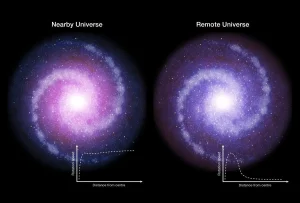
The elusive phenomenon known as dark matter may not actually exist, according to a University of Alabama astrophysicist, due to the possibility that gravity—an effect caused by the curving of the fabric of spacetime—may exist on its own in the absence of mass, despite the long-held assumption that gravity is directly generated by the mass of objects and energy.
Astronomers have long observed that there is not nearly enough visible mass in the universe to account for the gravitational effects being observed across the cosmos; the discrepancy is so pronounced that it is estimated that roughly 85 percent of the entire universe may be invisible to us, hence the phenomenon being referred to as ‘dark matter’.
However, this effect was first noticed over a century ago, as far back as 1884 in the appendices of Lord Kelvin’s Baltimore lectures on molecular dynamics and the wave theory of light; however, in the 140 years since, no evidence of such exotic “matter” has surfaced, despite extensive study being made of the phenomenon’s gravitational effects.
Having grown frustrated with the lack of progress in detecting dark matter, Dr. Richard Lieu, a professor of physics and astronomy with the University of Alabama, started looking to other possible sources for the unexplained abundance of gravity in the universe, including the potential that the curvature of spacetime that causes the effect may come from spacetime itself, and not generated by mass.
“This initiative is in turn driven by my frustration with the status quo, namely the notion of dark matter’s existence despite the lack of any direct evidence for a whole century,” Lieu explained.
Although his idea doesn’t discount the commonly-accepted notion that mass itself generates gravity, Lieu posits that the excess gravity that keeps galaxies and the larger neuron-shaped structures they form from flying apart is the result of concentric, shell-shaped defects in the topology (curvature) of local areas of spacetime.
These defects would have been caused by events that saw a change in the overall state of matter across the cosmos early in the history of the universe. These events are referred to as “phase transitions”, although Lieu admits that it is unclear as to “what precise form of phase transition in the universe could give rise to topological defects of this sort.”
Basically, these defects could be thought of as the result of an unknown phenomenon that curved localized areas of spacetime into such tight loops that they began acting as intense massless gravity wells; over time these regions would attract and accumulate matter, making their presence appear synonymous with the presence of mass.
“Topological effects are very compact regions of space with a very high density of matter, usually in the form of linear structures known as cosmic strings, although 2D structures such as spherical shells are also possible,” Lieu continued.
“The shells in my paper consist of a thin inner layer of positive mass and a thin outer layer of negative mass; the total mass of both layers—which is all one could measure, mass-wise—is exactly zero, but when a star lies on this shell it experiences a large gravitational force pulling it towards the center of the shell.”
This effect would also affect light—despite being a phenomenon that has no mass—a real-world phenomenon that has been observed through light being bent by massive objects, such as black holes or massive galaxies.
“Gravitational bending of light by a set of concentric singular shells comprising a galaxy or cluster is due to a ray of light being deflected slightly inwards—that is, towards the center of the large-scale structure, or the set of shells—as it passes through one shell,” much like when light is deflected as it passes through an optical lens.
If this massless-gravity effect is indeed real, then it should be measurable through the tried-and-true method of detecting large gravitational fields, by measuring the “the deflection of light and stellar orbital velocities”; however, “the contention of my paper is that at least the shells it posits are massless,” Lieu concludes. “There is then no need to perpetuate this seemingly endless search for dark matter.”
Subscribers, to watch the subscriber version of the video, first log in then click on Dreamland Subscriber-Only Video Podcast link.
This is science at works when theories that over time become dogma and fundamental truths until some start to look/investigate from a different point of view and posit an entirely new way of seeing. Big bang and now dark matter have for some time been the understanding of how things are even in common use by us all, except maybe not…